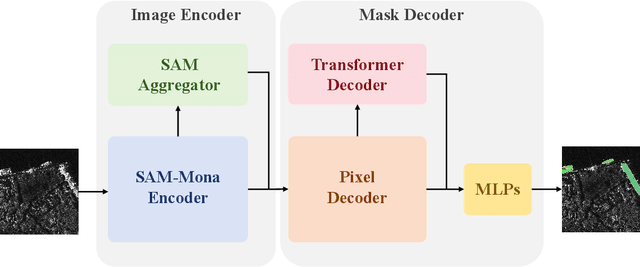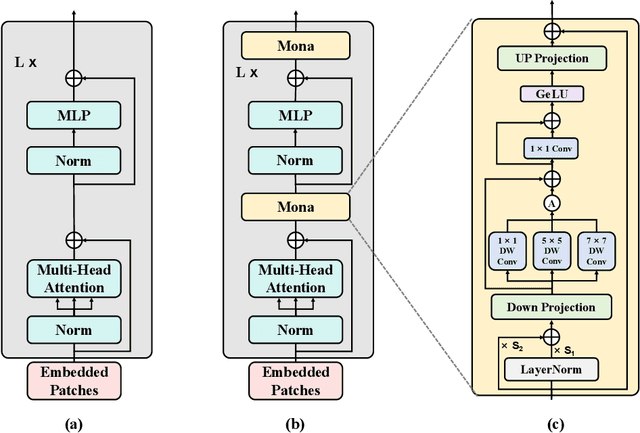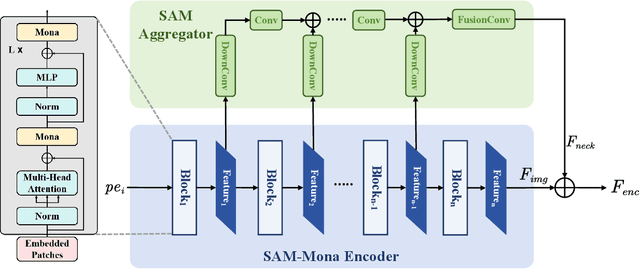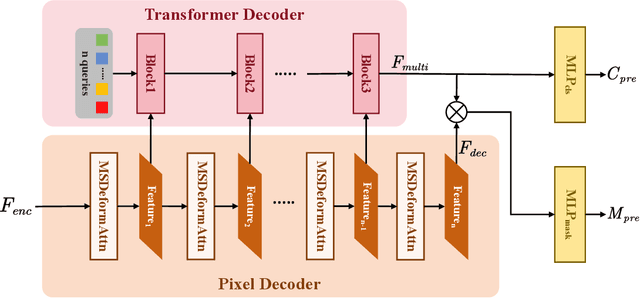Linghao Zheng
Tuning a SAM-Based Model with Multi-Cognitive Visual Adapter to Remote Sensing Instance Segmentation
Aug 16, 2024



Abstract:The Segment Anything Model (SAM), a foundational model designed for promptable segmentation tasks, demonstrates exceptional generalization capabilities, making it highly promising for natural scene image segmentation. However, SAM's lack of pretraining on massive remote sensing images and its interactive structure limit its automatic mask prediction capabilities. In this paper, a Multi-Cognitive SAM-Based Instance Segmentation Model (MC-SAM SEG) is introduced to employ SAM on remote sensing domain. The SAM-Mona encoder utilizing the Multi-cognitive Visual Adapter (Mona) is conducted to facilitate SAM's transfer learning in remote sensing applications. The proposed method named MC-SAM SEG extracts high-quality features by fine-tuning the SAM-Mona encoder along with a feature aggregator. Subsequently, a pixel decoder and transformer decoder are designed for prompt-free mask generation and instance classification. The comprehensive experiments are conducted on the HRSID and WHU datasets for instance segmentation tasks on Synthetic Aperture Radar (SAR) images and optical remote sensing images respectively. The evaluation results indicate the proposed method surpasses other deep learning algorithms and verify its effectiveness and generalization.
ClassWise-SAM-Adapter: Parameter Efficient Fine-tuning Adapts Segment Anything to SAR Domain for Semantic Segmentation
Jan 04, 2024Abstract:In the realm of artificial intelligence, the emergence of foundation models, backed by high computing capabilities and extensive data, has been revolutionary. Segment Anything Model (SAM), built on the Vision Transformer (ViT) model with millions of parameters and vast training dataset SA-1B, excels in various segmentation scenarios relying on its significance of semantic information and generalization ability. Such achievement of visual foundation model stimulates continuous researches on specific downstream tasks in computer vision. The ClassWise-SAM-Adapter (CWSAM) is designed to adapt the high-performing SAM for landcover classification on space-borne Synthetic Aperture Radar (SAR) images. The proposed CWSAM freezes most of SAM's parameters and incorporates lightweight adapters for parameter efficient fine-tuning, and a classwise mask decoder is designed to achieve semantic segmentation task. This adapt-tuning method allows for efficient landcover classification of SAR images, balancing the accuracy with computational demand. In addition, the task specific input module injects low frequency information of SAR images by MLP-based layers to improve the model performance. Compared to conventional state-of-the-art semantic segmentation algorithms by extensive experiments, CWSAM showcases enhanced performance with fewer computing resources, highlighting the potential of leveraging foundational models like SAM for specific downstream tasks in the SAR domain. The source code is available at: https://github.com/xypu98/CWSAM.
 Add to Chrome
Add to Chrome Add to Firefox
Add to Firefox Add to Edge
Add to Edge